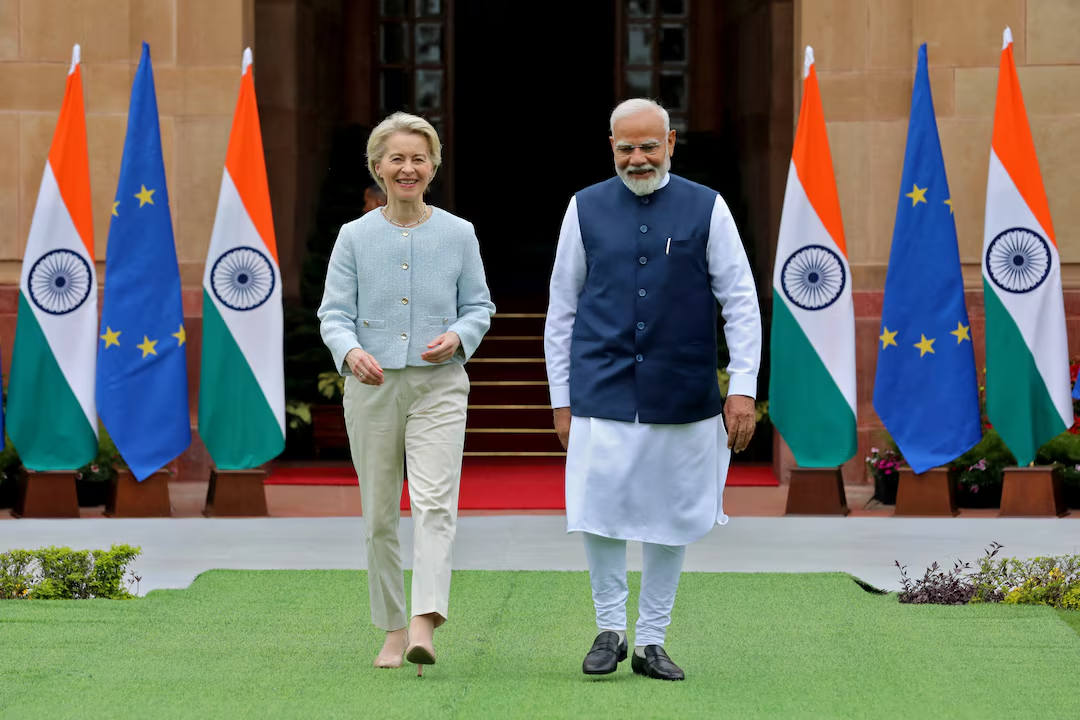The proposed India-EU Free Trade Agreement (FTA) is a significant development aimed at enhancing trade relations between India and the European Union. Here’s a breakdown of the key aspects of the FTA based on the latest discussions:
India-EU FTA: Key Aspects
- Delegation Visit & Leadership:
- A delegation led by European Commission President Ursula von der Leyen visited India on February 27, 2025, for a two-day visit.
- The delegation held talks with Prime Minister Narendra Modi and other senior ministers.
- This visit sets the stage for the next round of FTA talks, scheduled to take place in Brussels from March 10-14, 2025.
- India’s Priorities in the FTA:
- Support for MSMEs: India is advocating for concessions and support for its micro, small, and medium enterprises (MSMEs), which play a vital role in the country’s economy.
- Concerns Over Carbon Border Adjustment Mechanism (CBAM): India is particularly worried about the EU’s new Carbon Border Adjustment Mechanism, which could impose higher duties on energy-intensive goods like steel and aluminum exports from India.
- Textile Exports: India wants to address the additional 10% duty that Indian textile exports currently face when compared to competitors due to the absence of an FTA. Removing this duty is crucial to creating a level playing field for Indian exporters in the EU market.
- Services Sector & Labour Mobility: India seeks deeper integration with the EU’s services sector and better opportunities for skilled labor mobility, particularly in technology, IT, and business services.
- EU’s Demands in the FTA:
- Lower Tariffs on Key Exports: The EU is pushing for reduced tariffs on high-value exports such as whiskey, wine, and cars, which currently face significant barriers in India.
- Non-Tariff Barriers & Procurement Rules: The EU also wants India to ease non-tariff barriers and make its procurement rules more transparent and accessible to EU companies.
- The EU sees India as having a relatively closed market for its products and is seeking stronger commitments from India, not just on reducing tariffs but also on improving market access through procurement policies.
- Significance of the FTA:
- The EU is India’s largest trading partner after the United States, and the proposed FTA is one of the most significant trade agreements for India in recent years.
- The deal is expected to boost trade in various sectors, including textiles, automobiles, food and beverages, and services.
- Broader Context:
- The FTA talks with the EU are happening in parallel with similar trade discussions between India and the United Kingdom, which is no longer part of the EU after its Brexit withdrawal in 2020.
- Indian commerce and industry minister Piyush Goyal announced that India and the UK have restarted FTA negotiations after a one-year hiatus due to UK elections.
Key Challenges:
- Carbon Border Tax: The EU’s environmental regulations, like CBAM, could pose challenges for Indian exports, particularly in energy-intensive sectors.
- Tariff Reductions on Sensitive Products: India’s domestic industries, such as automobiles and agriculture, may resist lowering tariffs on EU products like luxury cars and alcoholic beverages.
- Services Trade: Negotiations around services trade and labor mobility will likely be complex, given EU’s focus on protecting its labor markets.
The India-EU FTA has the potential to reshape trade relations between the two economies, offering benefits in areas like textiles, technology, automobiles, and sustainability. However, both sides must navigate sensitive areas such as tariff reductions, environmental standards, and labor mobility to reach a balanced and mutually beneficial agreement.
